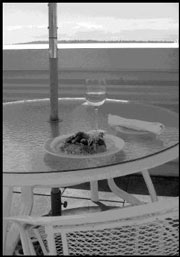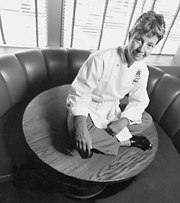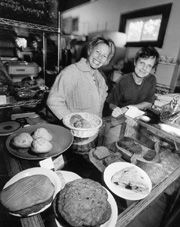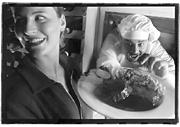96 UNION 96 Union, 623-3783 lunch 11:30 a.m.-3 p.m.; dinner 5-10 p.m. Sun.-Thurs., 5-11 p.m. Fri.-Sat.; brunch 10 a.m.-3 p.m. Sun. AE, DC, MC, V / full bar
A CLASSY LITTLE achiever has opened in the downtown space once inhabited by Leo Melina. Well, not exactly. Little it ain’t. Flung across several rooms and a veranda of Pike Place Market’s southernmost building at the tail end of Union Street, 96 Union offers numerous settings for diners: a cozy bar; a couple of uncommonly appealing private and semiprivate dining areas; a long main room done in sunny Mediterranean hues with brilliant red half-moon booths; and a broad deck (a fair piece from the restaurant) with a view over the bay. Since I dined here in June I can’t exactly report on the deck, but the other rooms look great, even when empty.
It also isn’t entirely accurate to call the place new. It’s been open since March, now offering the more casual pan-Mediterranean repertoire of new chef Bryan Weener (Sazerac’s first chef). But one should properly call this more of a renewal, because the owners are the same. They looked at the aging Leo Melina, a fancy, opera-playing, high-ticket—read: increasingly empty—destination restaurant, and opted for change.
Which is something this address has seen its share of. A decade or so ago Rosellini’s Other Place legendarily opened here, followed by an Asian restaurant you may have missed if you blinked, followed by Leo Melina’s, restaurant scion Leo Varchetta’s homage to his mamma Melina. (Her restaurant, Mamma Melina’s, is in the U District; his brother’s, Buongusto, is on Queen Anne.) Varchetta sold Leo Melina a few years ago to an anonymous investment group, which has now brought Weener’s vision to life.
That vision skews younger, more affordable, more stylish—opera has been replaced by jazz—and more suited to the way we eat today. The dinner menu features handfuls each of salads, pizzas, pastas, mezze (“Little Plates of the Good Stuff”), and mains; there’s even a section called “Seasonal Specialty” that lists, when we were there, a single item: warm sugar snap peas with mint and butter, for $5. It’s a whimsically random thing to see on a menu and a great sign, telling diners that here is a chef who saw glorious sweet snap peas in season and wanted to showcase them as more than a side player.
At dinner this creative promise was borne out. There were, of course, those sensational snap peas: impossibly sweet and drenched in butter, with bits of char and fresh mint clinging here and there. A fennel and arugula salad with orange slices, golden raisins, pine nuts, and feisty pecorino Romano ($8.50) made an eventful graze, full of texture and verve.
An unusual starter of fried polenta drenched in warm Gorgonzola cream and served with halved figs ($7) was inventive and rich but not unduly so. Ditto another uncommon mezze: risotto balls with smoked mozzarella and tomato relish ($6.50). Crispy outside, oozing melted mozzarella within, these strange creatures were fun, particularly when dredged in the extraordinarily throaty tomato relish. The smoke of the cheese was too aggressive, but otherwise this was an improbably winning starter of real ingenuity.
We also tried a pizza topped with fontina, pecorino, and a toss of herbs ($8), which featured a terrific crust. This time there wasn’t enough cheese to effectively counterpoint the aromatic herbs, but the flavor and crackle of the crust made up for a lot.
ASIDE FROM minor overcooking, our mains sustained the pleasure. Penne pasta with prawns ($18) was a simple but (mostly) well-executed dish, the delicious pasta beautifully offset with chard and intensely flavor-rich slow-roasted tomatoes—it was a shame the prawns were too tough.
A big piece of slightly over-roasted Alaskan halibut ($20) arrived over escarole and potato chunks in a broth subtly fragrant with saffron and fennel. Two slices of country bread were balanced atop, slathered with a red pepper-enhanced aioli called rouille. This was a dish of many virtues, not least of which was the fact that it functioned by turns as a soup, bread salad, and roasted fish plate. And tasty besides.
We finished with a soupy bowl of cherry gratin ($6) and a sensational orange-kissed flan ($6), concluding that, missteps notwithstanding, Weener’s was a kitchen of real creative energy. Would a brunch visit crush our thesis?
On the contrary: Banana-stuffed French toast ($9) was two broad mountain crags of stuffed brioche, unusually drenched with rich rum syrup. Salmon hash ($12) topped the peppers, onions, potatoes, and slow-roasted fish with a couple of softly poached eggs. A plate of warm, lightly sugared beignets ($5), those incomparable Louisiana doughnuts here the size and heft of golf balls, achieved both heaviness and lightness as only the best of their species will.
A frittata of spinach, mushrooms, and more of Weener’s unbelievably flavorful tomatoes ($9) was as satisfying and flavorful as breakfast is allowed to be. A potato leek pancake ($8) with little veins of goat cheese was, topped with a minty apple ragout, a wonderment of unlikely complementary flavors—another testament to Weener’s creative sparkle in the kitchen. So why all the empty tables? It’s new, and there are a lot of tables to fill. If Weener can’t do it, it may not be doable at all.








